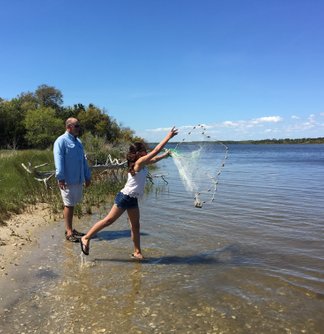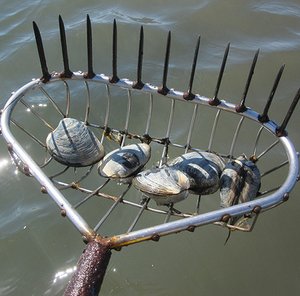Tours
Dolphin Watching
North Carolina's 2.3 million acres of brackish waters and productive fish nursery areas offer prime habitat for bottlenose dolphins to live and raise their young. The waters around Topsail Island provide fantastic places to watch dolphins. The exhilaration and awe of seeing such beautiful wildlife surface nearby, glide along-side our boat or even sometimes jump completely out of the water during a Lost Treasure Ecotours dolphin watch is hard to match. When seas are calm, customers can even hear them come up, expel water, and breathe. During the summer these intelligent animals will take their young into backwater nursery areas, where food is abundant and predators scarce. During the fall and early winter dolphins will move out of our estuaries into the near-shore ocean waters, hunting the millions of fish migrating from North Carolina's shallow sounds. Customers are sometimes fortunate to see huge pods of these animals congregating to feed.
Dolphins can be seen in North Carolina's waters almost year-round. Some researchers feel North Carolina has a specific estuarine/near shore population of bottlenose dolphins, in addition to multiple other populations. Lost Treasure Ecotours will take observers to areas where dolphins are usually common. Sometimes customers are even able to get clear pictures of them swimming and playing. Our vessel can quickly maneuver and is fast enough to get a good view of these special creatures and still make sure they remain unharmed. Seeing dolphins near your boat on a Lost Treasure Ecotour is truly an unforgettable moment.
Birding
Coastal North Carolina is renowned for bird watching. Over 400 species have been identified in the area. Our habitat diversity and location near the midpoint of the United States Atlantic coast allow us to see birds both associated with warm and cold climates. The almost tropical waters of the Gulf Stream just off our coast also provide opportunities to observe birds one might not see otherwise. Birds of all sizes, shapes and colors can be seen along the extensive barrier islands, maritime forests, marshes, sounds, and near-ocean waters of the Southern Outer Banks. Major migratory routes for numerous water birds lie just off our coast, with some birds venturing near inlets. In the fall, land birds are known to migrate southward along North Carolina's barrier islands. During winter frequent flocks of waterfowl are commonly observed along our waterways. Many water birds, such as brown pelicans, terns, oyster catchers, skimmers, and gulls nest during spring/summer.
Lost Treasure Ecotours is equipped to take you to secluded observation areas and can easily navigate the shallow estuaries to provide ample birding opportunities. Let us help you experience some of the best bird watching in the eastern United States.
Crabbing
The blue crab is North Carolina's most important commercially harvested species. More people ply the waters of Pamlico Sound and its tributaries to commercially catch this crusty crustacean than any other aquatic animal in North Carolina. The biology of blue crabs is like a fairy tale, with their "fingernail painted" red-tipped clawed females (sooks) carrying batches of fertilized eggs to spawning areas near inlets, and the larger blue-tipped clawed males (jimmys) preferring fresher waters to scavenge and mate. Amazingly, the blue crab will literally burst out of a confining shell when its mass has outgrown its skeleton. This renewed creature is soft for several hours, until enough minerals have been absorbed from the surrounding waters, when it miraculously becomes hard again.
Lost Treasure Ecotours has their own crab pots allowing participants to experience the thrill of harvesting crabs the way the local watermen do. We also have crab lines that can be fished from our boat or the shore, providing the opportunity to catch your very own crab with a dip net. Throughout the crabbing adventure Capt. Will, can explain how important they are to North Carolina coastal communities. Come encounter one of North Carolina's most important estuarine resources, the blue crab.
Cast Netting

Most people do not know that the shallow brackish creeks and bays of North Carolina serve as a nursery area for 90% of the fish and shellfish species harvested commercially in the state. Most of the fish that are important to our commercial and recreational fisheries spawn in the ocean and their young make these areas their temporary homes. High salinity submerged grass beds also offer vital nurseries for numerous species of fish and shellfish.
Lost Treasure Ecotours can provide the opportunity for people to experience these spectacular kindergartens of the sea. We can easily take participants to areas containing grass beds or shallow creeks. Touch with wonder the hundreds of young fish, crabs, and shrimp that live in those very waters. Listen as Capt. Will describes the fascinating organisms observed, their habitats, and their social and ecological importance. Also available are several sizes of cast nets for those who would like to try their hand at catching fish in this unique way.
Clamming
Come experience what fishermen and locals have enjoyed in Carteret County for generations - the thrill of searching and catching your very own clams for dinner! Onslow/Pender Counties are renowned for their tasty clams.
Lost Treasure Ecotours will take you to areas that are only accessible by boat where the waters are clean, the area is filled with natural beauty and clams can be harvested. We will provide all of the gear necessary to catch these delicious bivalves. Captain Will provides instruction on how to "dig & feel" the clams with your clam rake and then retrieve them from the ground. You will have the opportunity to experience the exhilaration of harvesting your own clams for the first time. This is one of many ways to have a wonderful time on a Lost Treasure Ecotour

Aligator Watching
Coming Soon!

